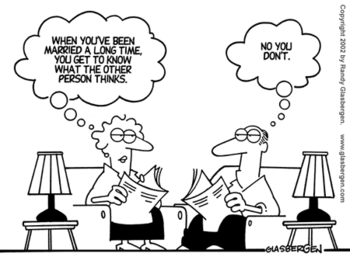The proper basis for a marriage is mutual misunderstanding. —Oscar Wilde
 People necessarily make use of assumptions in speaking to one another, choosing their words to convey necessary information succinctly and effectively. The assumption process creates a theory of mind regarding the audience, including their culture, motivations, previous experiences, etc. While communicating with a stranger or an unfamiliar audience, the speaker will seek to include extra detail or background to be certain that the message is understood. But old acquaintances share more history and might require less information to understand the speaker’s intent (and may regard excessive detail as condescension). This habit promotes quick and effortless communication. Reciprocal theories of mind between long-time friends will grow into a shared ecosystem, with experiences, inside jokes and deep comprehension.
People necessarily make use of assumptions in speaking to one another, choosing their words to convey necessary information succinctly and effectively. The assumption process creates a theory of mind regarding the audience, including their culture, motivations, previous experiences, etc. While communicating with a stranger or an unfamiliar audience, the speaker will seek to include extra detail or background to be certain that the message is understood. But old acquaintances share more history and might require less information to understand the speaker’s intent (and may regard excessive detail as condescension). This habit promotes quick and effortless communication. Reciprocal theories of mind between long-time friends will grow into a shared ecosystem, with experiences, inside jokes and deep comprehension.
Or not. In the case of long-married couples, spouses sometimes communicate ambiguous information no better than strangers would. Two psychologists, Boaz Keysar and Kenneth Savitzky, have been studying how people interpret and misinterpret ambiguous communications. They devised an experiment in which participants sat in a circle with their backs to one other and tried to discern the meaning of spoken ambiguous phrases chosen from everyday conversations. The “speaker” was given a list of ambiguous phrases, and instructed to read each one aloud to communicate which of four meanings was intended. For example, “it’s getting hot in here” might be a flirtatious overture, a comment about tempers rising, a warning that the cops are closing in, or a hint to open the window. The listeners in the experiment chose from among the four possible meanings based on the speaker’s verbal delivery, and the speaker would rate the likelihood that each listener got the correct message.
Even with a lot of contextual information stripped away, all listeners were able to guess the speaker’s intent at well above chance levels, which is a testament to the utility of the social assumptions the researchers are investigating. However, the speakers in this experiment consistently overestimated their own ability to communicate the appropriate meaning, and they overestimated their ability more so toward their partners than toward the strangers. They thought their spouses “got it” for 6 out of 10 phrases, when in fact the spouses averaged the same as strangers, at around 4 out of 10.
The scientists who designed this study chose the conditions to illustrate the flip side of a developed intimacy. The habits of ellipsis and allusion can become counterproductive when the topic falls outside of the shared sphere, or, as in this experiment, context is removed to the point of real ambiguity (in real life, think of emails or text messages; or, speaking near a running faucet). Speakers presume that they’re being clear; and a listener, may use their own take on the shared relationship to mistakenly believe they don’t need clarification. Preventing this sort of miscue is the basis for an entire cottage industry of counselors and marriage therapists.
Reference:The closeness-communication bias: Increased egocentrism among friends versus strangers. Kenneth Savitsky, Boaz Keysar, Nicholas Epley, Travis Carter, and Ashley Swanson. J. Exp. Soc. Psychology 47:269-273, 2011.
Cartoon © Randy Glasbergen from www.glasbergen.com <http://www.glasbergen.com>, used with permission.

